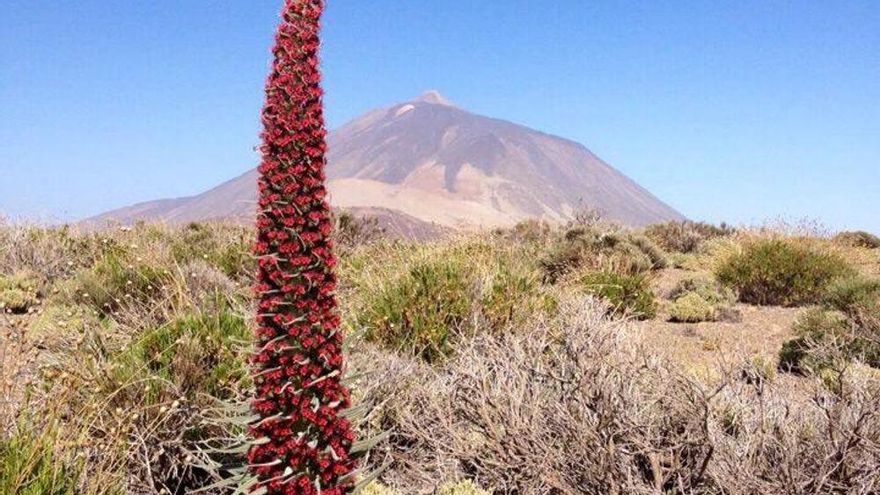
A new inventory to delve deeply into the biodiversity of Teide from a scientific perspective. Specifically, the record of plant species inhabiting the most visited National Park in Spain with over four million visitors annually. The Official Gazette of the Canary Islands (BOC) published this week the agreement, through a contract, between the Canarian Institute of Agrarian Research (ICIA) and the public company Territorial and Environmental Management and Planning (Gesplan) to develop until November 30, 2025, with the possibility of an extension, the project of inventorying the flora in the symbol of the Island and the Archipelago. Updated documentary sources establish that there are 195 taxa, which equates to plant species, in the main protected natural area of the Canary Islands. Among them are iconic species of the environment and all of Tenerife such as the red tajinaste or the violet of Teide. The number could increase by a couple of dozens based on the sporadic presence of arable plants (those that grow on crops) that are occasionally seen around the most humanized areas. The presumed detailed study now aims to obtain an accurate record.
Endemism
[–>
Among the set of taxa identified in the Teide National Park, 31 are endemic to the Archipelago and 33 are specific to Tenerife, which represents almost 32% of endemism (only found in this territory). Several taxa like Viola guaxarensis, Helianthemum juliae (Las Cañadas rockrose), Rhaponticum canariense (silver thistle), Silene nocteolens (rabbit herb), Laphangium teydeum (Teide buckwheat), Rosa dumalis spp. teydensis or Viola cheiranthifolia (Teide violet) are entirely exclusive. Others could join them with almost 90% of effectiveness within the natural area.
Fluctuations
[–>
There are several causes for these fluctuations when determining the number of species. On one hand, the process of climate change, which is becoming a serious problem for the conservation of many high-mountain species and even for the structure of the plant community in general, as with rising temperatures, many plant species – and by extension the invertebrate fauna associated with them – spread while others undergo significant setbacks. In fact, these expansion or regression movements precisely constitute one of the most common indicators of the climate change process itself. On the other hand, introduced herbivores – rabbits and mouflons in the case of the Teide National Park – tend to feed on the most palatable taxa – the quality of being pleasing to the palate as food – causing significant alterations in the dynamics of their populations. Thirdly, the arrival of potentially invasive species, such as Bromus tectorum (commonly known as downy brome) and Lactuca serriola (prickly lettuce, the wild relative closest to lettuce) possibly as a result of the significant traffic of visitors to the National Park. Finally, the evolution of technology experienced in these last twenty years must also be taken into account, as it currently allows for much more precise results, especially for areas with complex topography where access may be limited.
Methodology
[–>
The entire area of the Teide National Park will be divided into 861 grids of 500×500 meters – the total area is 189.9 square kilometers, equivalent to 18,990,000 hectares (the same as as many football fields) – which will be the subject of study. Each grid will be subdivided into four grids of 250×250, where the presence list of each taxon will be independent for each one. One of the control variables will be measuring the density or abundance of the taxa in each sub-grid, in addition to being able to obtain more detailed information. Sampling will be direct with the visual search for live or dead plant taxa, as well as their remains (stumps, etc.) that can be identifiable. Binoculars or a telescope can also be used.
Botanical Jewels
[–>
Walking through the Teide National Park – always in permitted hiking areas – is to encounter amidst a desolate landscape, the astonishing growth of vegetation. The impression is even greater when seeing dozens of blooming tajinastes. Intense colour in their flowers, reds and blues, in contrast to the darkness of the earth and the mountains. A unique spectacle, that of decisive botanical treasures in the declaration as a National Park in 1954. Visitors will observe that all areas where the soil offers minimal conditions have been colonised by a rich plant world. It is formed by grey-green bushes and tiny leaves, demonstrating a perfect adaptation to extreme conditions of drought, light intensity, solar radiation, and large temperature fluctuations. Broom is the most widespread, although also associated are feather grass, tree heath, Teide daisy, Teide wallflower, and lava field flower. It is also easy to find summit grass, sneezewort, red tajinaste, spicy tajinaste, and silver thistle. The red tajinaste (Echium wildpretii) is one of the most spectacular plants in the National Park, reaching over two meters in height. Meanwhile, the spicy tajinaste (Echium auberianum) is a Tenerife endemic very similar to the red one, although with blue flowers and smaller size. The violet of Teide (Viola cheiranthifolia) is also found only here. Its beauty and uniqueness make it necessary to remember that it is prohibited to cut or uproot it, just like the rest of the plants in the area. In recent times, given so much irresponsibility, these types of messages take on a whole new meaning. Between April and June, the Teide National Park is the setting for an explosion of life and colour: bushes and shrubs are adorned with flowers, the air is scented with their aromas, and there are also plenty of pollinating insects. The cycle of life.
















